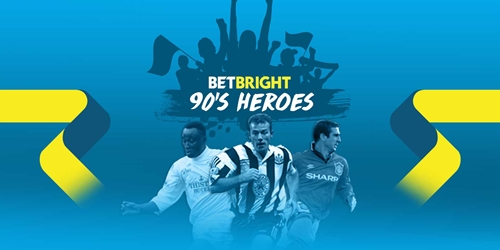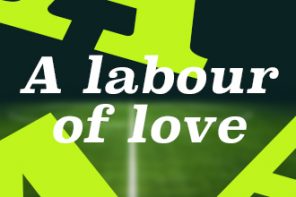’90s Heroes is a series by Adam Hurrey on the Bet Bright football blog which looks back on the legends of the game in what now seems a simpler time for football.
Duncan Ferguson; Jurgen Klinsmann; Faustino Asprilla; Juninho; Tony Yeboah; Georgi Kinkladze; David Ginola; Chris Waddle; Gianfranco Zola; Niall Quinn and Kevin Phillips; Dion Dublin; Robbie Fowler; Stuart Pearce; Mark Hughes; Paul Gascoigne; Matt Le Tissier; Ron Atkinson and Richard Keys; Teddy Sheringham; Dennis Bergkamp; Neil ‘Razor’ Ruddock; Chesterfield FA Cup Heroes; Sky Sports adverts of the 1990s; Kevin Francis; David Platt; Romario.
“He is addicted to football,” said his former Real Madrid manager Vicente del Bosque. “The ball is like a drug to him.” It’s unsurprising, then, to see the beaming grin of Roberto Carlos – 44 years old this spring – fronting the promotional efforts for the inaugural (and, I am obliged to say, “star-studded”) Star Sixes tournament at the O2 Arena in July. God help the goalkeepers.
As the similarly-endowed Stuart Pearce demonstrated half a generation or so before our latest hero, a full-back needs something special to stand out among the number 9s and 10s.
The brutally straightforward USP of Roberto Carlos didn’t take long to show itself, but it did need a while to be fine-tuned: before he spent more than a decade at Real Madrid, his career path could have been rather less glamorous. It’s not entirely clear how close Barry Fry’s Birmingham City were to combining a Brazilian international with Big Kevin Francis in the second tier of English football, but one can only dream of a left-wing partnership of Roberto Carlos and Ricky Otto on a Tuesday night at Grimsby Town.
Hard to remember Roberto Carlos with hair. Here he is back in 1990 when playing with União São João pic.twitter.com/6mutffcBWk
— Beyond The Last Man (@BeyondTLM) February 8, 2014
Birmingham weren’t alone in the early-90s chase. Doug Ellis reportedly fancied Roberto Carlos for his Aston Villa side, only for Brian Little to veto the move (again, details are scarce, but it’s nice to imagine the conversation) before Middlesbrough came closest of all: a £7m bid in January 1996 was unsuccessful, however, and they settled for an older model of the Brazilian Left-Back Who Needs No Second Invitation To Shoot, in the substantial shape of Branco.
The template had been firmly established, and Roberto Carlos was sticking to it. Palmeiras, the third stage of his Brazilian primary education after União São João and Atletico Mineiro, was where he finally began to specialise.
Two consecutive Brazilian league titles crowned his early-20s apprenticeship, and Roberto Carlos’ long-range ambitions were aimed at European football.
By 1995, he was a regular in the yellow, green and blue of the national side but – in a rare aside for the otherwise humble pursuit of full-backing – his first 14 caps had come without troubling the structural integrity of a goalnet.
Then came the Umbro Cup in England – the sort of pre-tournament ramping-up event that Roberto Carlos would later establish as his showcase – and the novel prospect of Japan at Goodison Park. That international goal drought – a concept that wouldn’t bother your usual 22-year-old left-back – would last only six more minutes.
That rippling of an English goalnet may have enticed the likes of Birmingham and Middlesbrough, but Roberto Carlos weighed things up and decided that Milan, and Inter, would be a better bet.
Roberto Carlos, Inter, 1995/96. pic.twitter.com/LIwAmekRT3
— A Football Archive* (@FootballArchive) February 15, 2016
Arriving at the San Siro as part of a trio of summer signings – alongside Paul Ince and Javier Zanetti – Roberto Carlos made an immediate impact. A 30-yard, daisy-cutting free-kick earned a 1-0 win over Vicenza on his Serie A debut, and he finished the season as Inter’s third top-scorer.
The one man who wasn’t impressed, however, was manager Roy Hodgson. Unconvinced by the Brazilian’s capabilities on the back foot, he allowed Roberto Carlos to leave after just one season. At best, the reaction was mixed – one sarcastic verbal assault on Italian TV from Gazzetta dello Sport journalist Maurizio Mosca, though, left Hodgson in no doubt:
“Great compliments to Mr Hodgson for the job he did at Inter,” seethed journalist Mosca. “Well done for making Roberto Carlos leave.”
The player himself was equally put out. “Hodgson’s stay at Inter destroyed me,” Roberto Carlos later recalled. “It’s not that I did not have a good relationship with Hodgson. It is just that Hodgson doesn’t know much about football.”
Whatever Hodgson’s reservations about the Roberto Carlos’ repertoire, it was clear that the 23-year-old’s primary weapon was close to being battle-ready. Parma goalkeeper Luca Bucci, for example, made an unwitting audition for the role of a statuesque Fabien Barthez.
Once Roberto Carlos’ departure was inevitable, incoming Real Madrid manager Fabio Capello moved swiftly to take advantage. “I couldn’t believe it. I sent a fax, spoke with the president and the next day the deal was done. It could have been the quickest signing in history.” The fee was a low-risk £5m, and Inter’s oversight was complete.
Real had captured themselves a bargain, but couldn’t quite have envisaged just how firmly Roberto Carlos would become part of the Bernabeu furniture. Well on the way to his peak-years physique – when he looked like a sports hatchback – their new No.3 helped propel them to the league title and, in turn, the Champions League title in 1998. His other-worldly goal against Tenerife, meanwhile, was another significant addition to the Roberto Carlos scrapbook.
Such is the power, trajectory and uniqueness of that goal, it doesn’t actually matter whether he meant it or not. In hindsight, it’s the ultimate pre-Twitter, pre-YouTube, pre-saturation point goal – one you might have first encountered via a second-hand account in the playground from someone whose parents actually allowed them to have Sky Sports on cable.
Inevitably, though, this retrospective – much like a Roberto Carlos free-kick, when the stars occasionally aligned – can lead to only one place. Le Tournoi, June 3rd, 1997.
This, as the pragmatists like to point out, was the free-kick that justified 1,000 unsuccessful future efforts to repeat it for club and country. The watching England players, as stunned as Barthez and the ducking ballboy, tried to recreate it at training the next day, only to repeatedly pepper a French A-road instead. This was cartoon football, for a generation of TV viewers still getting to grips with exotic foreign talent, destined to be turned into retro 8-bit tributes.
It was also just his second goal for Brazil, another 15 caps after he’d broken that duck against Japan on Merseyside. No matter how many subsequent set-pieces slammed into unfortunate thighs in defensive walls after that, the legend was intact, as the Independent wrote in 2002:
“The Brazilian’s venomous free-kicks, for example, are regarded as almost a sacred act, to be venerated by all football worshippers. His 40-yarder against the hosts in the Tournoi de France in 1997 can be regarded as such. Against Belgium, the crowd hand-clapped the Real Madrid defender’s approach to the ball as they might an Olympic long jumper his approach. Yet, his goal against China – the first of Brazil’s four that day – was also his first for his country since that free kick five years ago.”
When his Real Madrid time was finally called, those absurdly-shaped legs hadn’t quite gone. Roberto Carlos – without any hint of cynicism, it should be said – took his appetite for bombing on down the left flank to Istanbul, Dagestan and Delhi before those tightly-fitted Umbro Specialis were finally hung up.
There was still time in those twilight years for some more tentative English enquiries. Roman Abramovich took it upon himself to try and persuade the human cannonball to join Chelsea in 2006, to no avail. Finally, the Munto-financed, Sven-Goran Eriksson-afflicted Notts County reportedly tried to sign him in 2009. Even for a fantasy footballer like Roberto Carlos, there are limits.
For the latest instalment of ’90s Heroes check out the Bet Bright football blog this week.







